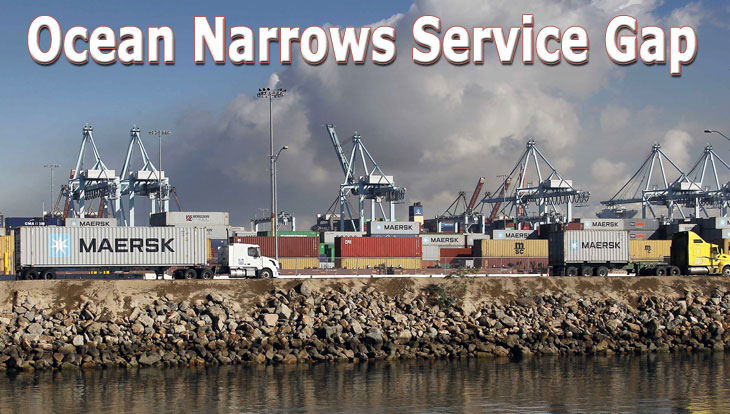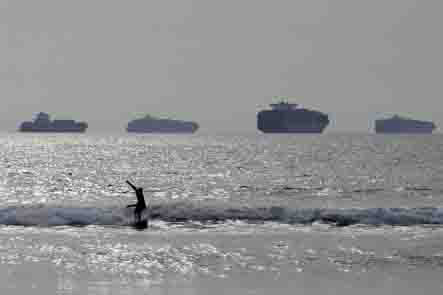
 Heavy
consignments and growing service options as heavy rigs
offload cargo after arrival at Port of Los Angeles. Catch a Wave . . . Jake Ferguson rides a wave in
Sunset Beach, Calif., as loaded cargo ships are anchored
outside the Ports of Long Beach and Los Angeles. Heavy
consignments and growing service options as heavy rigs
offload cargo after arrival at Port of Los Angeles. Catch a Wave . . . Jake Ferguson rides a wave in
Sunset Beach, Calif., as loaded cargo ships are anchored
outside the Ports of Long Beach and Los Angeles.
The modal
shift from air to ocean has been an ongoing trend during
2015, especially since the U.S. West Coast port strike
disruption that blighted Transpacific
trades dissipated in the first quarter and normal shipping
services resumed. The modal shift away from air is expected
to continue over the short and long-term according to
most executives interviewed by FlyingTypers,
at least when major electronics launches don’t
give the air freight industry a seasonal spike.
But while using ocean
over air where possible is a sensible and understandable
long-term supply chain cost management tool for some,
there are also increasingly benefits of ocean shipping
that make inventory management an easier and less risky
task for shippers and 3PLs.
Lower
Rates Only Part Of The Story
At the moment, not only
are ocean container rates at historic lows, but the
latest research suggests that container lines are upping
their game on service reliability—a trend aided
by excess capacity, slow steaming strategies, slow demand
growth, and the more structured alliance systems implemented
by lines over the last year or two.
In results published late
last year, Danish analysts SeaIntel found that global
liner schedule reliability in September continued the
upward trajectory recorded for much of 2015. Indeed,
reliability of 86 percent in September was up by 4.6
percent in August and 13 points higher than a year earlier.
The analyst’s 50th
issue of its Global Liner Performance report, which
is based on 11,792 vessel arrivals in September, also
found that the average delay for late vessels had fallen
to its lowest average level, decreasing to 3.30 days
in September from 3.51 days in August, and 3.82 days
in September 2014.
No
Flash In The Pan
 More
worryingly for the air cargo industry, the trend toward
greater reliability was no September flash in the pan.
Mr. Eligio Fanigliulo, (right) Shipping Analyst at SeaIntel,
said reliability trends in 2015 were up 18.7 points
over the first three quarters and highly attractive
to shippers. “The global improvement has clearly
been driven by the performance increases of the East/West
trades, where 6 out of the 8 East/West trade lanes have
reached the highest level of 2015 in September,”
he added. More
worryingly for the air cargo industry, the trend toward
greater reliability was no September flash in the pan.
Mr. Eligio Fanigliulo, (right) Shipping Analyst at SeaIntel,
said reliability trends in 2015 were up 18.7 points
over the first three quarters and highly attractive
to shippers. “The global improvement has clearly
been driven by the performance increases of the East/West
trades, where 6 out of the 8 East/West trade lanes have
reached the highest level of 2015 in September,”
he added.
All of the world’s
Top 20 carriers recorded improved reliability from August
to September, with gains ranging from between 2.6 and
8.1 points. Japanese line MOL retained its top place
in September for a second month with on-time performance
of 92.6 percent, followed by K Line at 90.7 percent
and APL at 90.5 percent. The stragglers were MSC, Hamburg
Süd, and CSCL at 84.5 percent, 85.4 percent, and
86 percent of on-time performance, respectively.
Who
Is Reliable?
SeaIntel also examined
head-haul services in isolation. MOL was the most reliable
carrier overall in Q3 as well as in head-haul services,
but elsewhere among the Top 20 carriers there is considerable
differences between (for shippers) all-important head-haul
performance and global reliability. For example, Maersk
Line and Evergreen were, respectively, the second and
third most reliable carriers based just on the head
haul calls, while they ranked tenth and eleventh based
on all deep-sea calls.
“We were surprised
to see the large difference between head haul and full
round-trip rotation for some of the carriers,”
said CEO and Partner in SeaIntel Alan Murphy.
Impact
of Alliances
Shipping alliances have
also had a mixed impact on performance. Murphy said
in the first four years of monitoring schedule reliability
Hamburg Süd was consistently in the top-2 performers,
but after teaming up with the Ocean Three carriers—an
alliance consisting of CMA CGM, China Shipping Container
Lines, and United Arab Shipping Company—on East-West
trades, the German carrier had fallen down the scale
dramatically.
“For Hamburg Süd
the difference between their global performance and
East-West performance is no less than 9.7 percentage
points in 2015-Q3, but for many of the other carriers
the difference is only between 2-4 percentage points,”
he said. “With differences in global carrier reliability
being relatively narrow in Q3, the difference of a couple
of percentage points greatly influences the ranking
of carriers.
“This clearly shows
that the performance in the East-West trades might be
interesting, but could certainly not serve as a trustworthy
proxy for global performance on the deep-sea trades.”
The liner industry may
have become more commoditized, but for users it is still
clearly worth knowing which line will take possession
of your cargo if reliable delivery is a key factor in
inventory management.
SkyKing
|



